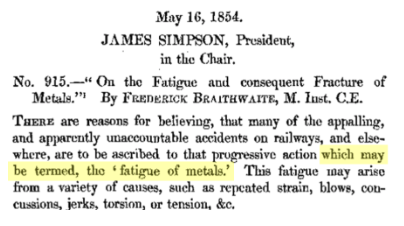What is Fatigue?
Simply put:
Fatigue is a weakening and cracking of a material due to cyclic loading.
There are many sources and occurrences of metal fatigue in the chemical process and refining industries. They range from low-cycle thermal stresses in a fluidized catalytic cracking unit (FCCU), to the relentless pressure cycling of a pressure swing adsorber (PSA), to the ultra-high cycles of a rotating pump or motor shaft.
A Little History…
It seems that a basic understanding of fatigue began to develop in the early 1800s. In 1829, Wilhelm Albert (working in the mining industry) noted the failure of metal cables that seemed to be caused by cyclic loading. This may have been the first recorded reference to what eventually became known as “metal fatigue.”
The Scottish mechanical engineer, William Rankine, studied failed railcar axles in the 1840s and observed that the failures were related to cracks emanating from a stress concentration on the shaft. (Rankine also developed the “Rankine” temperature scale.)
The term “fatigue” itself evolved during this period. In 1839, Jean-Victor Poncelet referred to metals as “tired” in his lectures at the military school at Metz. “Tired” later evolved into “fatigue” when Frederick Braithwaite coined the term "fatigue" in his 1854 paper to the Institution of Civil Engineers, entitled "On the fatigue and consequent fracture of metals." He used the term to describe the cracking of metals under cyclic loadings. See Figure 1 for an excerpt from the 1854 paper.

Today, we have a much better understanding of fatigue. In our industry, there are myriad of potential fatigue sources. In many cases, the underlying phenomena may be unavoidable (e.g., the thermal cycling of an FCCU or the rotation of a shaft), but there are many things that the engineer can do to improve the situation.
Origins of Fatigue
API 579 lists a number of the major driving forces of fatigue. These are summarized in Table 1 below. Thus, if periodic mechanical loading due to an out-of-balance pump is the source of fatigue, fixing the imbalance is probably going to be the most effective way of dealing with the problem. But sometimes, the driving force is inherent to the process, such as cyclic pressure loading in a PSA vessel. In this case, other methods can be applied to improve the fatigue life.

















Comments and Discussion
Add a Comment
Please log in or register to participate in comments and discussions.